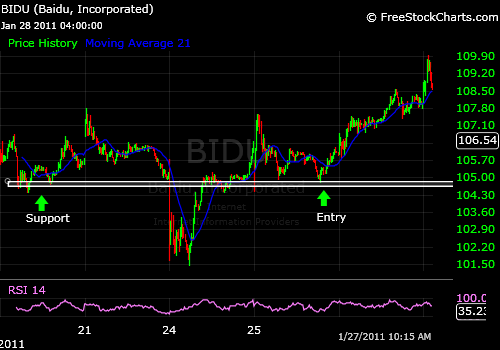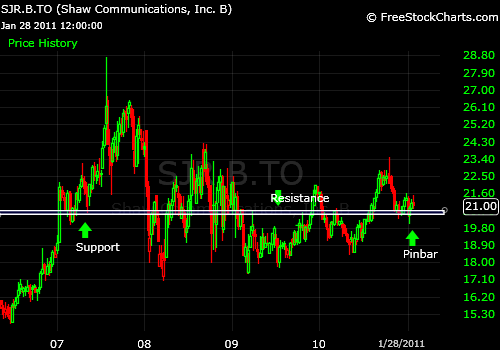Note: This interview was carried out on Jan 31, 2011.
Biography: Hsing-Tsai (Mark) Li has been trading currencies and equities for over four years using technical and fundamental analysis as the basis of his trading. He is currently working with the Bank of Montreal as an Investment Specialist. Mark currently holds the Derivatives Market Specialist (DMS) designation and is a CFA Level 2 and CMT Level 2 candidate.
Mark can be found blogging at http://marktekfx.wordpress.com/
Q: Mark, tell us a bit about how you got interested in investing/trading?
A: My interest in investing dates back to 2006, when I came across a Forbes article entitled “The World’s Richest People” which listed Bill Gates as the richest person in the world followed by Warren Buffett. After reading both profiles, I came to a conclusion that I would follow the path of Warren Buffet, the Oracle of Omaha, since in my junior years I was never good at programming and was infatuated with numbers and economics. One of the qualities I liked about Warren Buffett was how he simplified investing and in every interview he spoke in a layman’s language which would be understood by everybody.
Q: How (and from what sources) did you learn technical analysis?
A: Initially I based my investing purely on fundamental analysis. However, over a period of months, I realized even though some of the companies had good fundamentals, I was still buying companies at disadvantageous prices. In 2007, I came across a book by Steve Nison called “Japanese Candlestick Charting Techniques![]() ” which led to my interest in technical analysis and helped me improve my decision making skills on what prices to buy or sell an investment. Another book which had an huge impact on my trading is the “Encyclopedia of Chart Patterns
” which led to my interest in technical analysis and helped me improve my decision making skills on what prices to buy or sell an investment. Another book which had an huge impact on my trading is the “Encyclopedia of Chart Patterns![]() ” by Thomas N. Bulkowski which contains information on important chart patterns and also the statistics of each pattern’s success and fail rate.
” by Thomas N. Bulkowski which contains information on important chart patterns and also the statistics of each pattern’s success and fail rate.
Q: How would you describe your current strategy (in terms of the types of trades you enter, position sizing, the duration you hold) when it comes to trading equities? How much attention do you pay to fundamental analysis?
A: I currently have two types of accounts: one is for short-term trading which involves trades that are closed within the trading day and I also have a long-term account in which trades are left open anywhere from a couple of days to a couple of months depending on when the price target is achieved. For my short-term trading account, position sizing is usually smaller since its easier to get in and out of the market and easier to manage the risk involved with each trade. On the other hand, for my long term accounts, position sizes are usually larger.
Personally, for short term trading, decisions are based purely on technical analysis, since my price targets are smaller whereas for long-term trades, I scan the equities based on technical analysis and then I apply fundamental analysis to determine whether I should buy or sell a particular company.
Q: Can you walk us through how you came to develop your personal strategy?
A: For short term trades, I use candlestick patterns, support and resistance areas also known as regions of interest and technical indicators to determine my entry and exit points and for longer term trends I use only candlestick patterns, support and resistance areas.
Personally to determine which technical indicator works on short time frames, it depends on using different values for a particular technical indicator, for example: some stocks can easily be determined to buy or sell by using 13 day EMA (exponential moving average) on 5 minute time frames, on the other hand the same moving average might not be useful for a different stock or even for a different time frame for the same stock, hence technical indicators would be useful as long as its customized and backtested during different time periods. To backtest a technical indicator for shorter time frames requires a lot more time since it involves evaluating the behavior of a particular stock over extended periods of time, which might involve analyzing upto 20 years of historical price data.
Q: From the plethora of available technical indicators, which ones do you pay most attention to when analyzing equities?
A: For my short-term trading, I use RSI (Relative Strength Index) which simply compares the magnitude of recent gains to recent losses to determine if a particular stock is overbought (potentially time to sell) or oversold (potentially time to buy). I also use moving averages which help in determining the direction of the trend.
For example in the chart above, I have drawn the rectangular area which is a region of interest i.e. the rectangular region first becomes a support (failure of price to go lower), after which it becomes a consolidation. On Jan 25th at 3:00 pm EST the price falls into this region, forms a bullish candle (price opens lower and closes higher than the previous candle) in the region of interest and RSI (Relative Strength Index) has a crossover of 50 indicating buyers overpowering sellers.
Q: If you do form a technical opinion on the broader markets especially when it comes to equities, what asset classes and indices do you look at? If you strictly focus on specific equities, how do you source or find these ideas (screens, blogs, newsletters etc.)?
A: I focus primarily on individual stocks or securities. To find an idea, I scan through hundred for charts everyday looking for candlestick formations in the support (failure of price to go lower) or resistance (failure of price to go higher) areas. I have two set of watch-lists which I go through every day, one is based on large cap stocks and the second is based on small cap stocks.
Q: Now that we’ve gotten some background on how you trade, Mark, why don’t we transition to some trades ideas that you are looking at. In terms of equities, can you let us in on a trade that you are in or are currently looking at? Perhaps you can talk about what specifically in the price chart makes you want to enter this trade (and what would make you want to exit the trade), your entry, stop loss and exit price?
A: One of the stocks I am currently looking at is Shaw Communications (SRJ.B:TSX) traded on Toronto Stock Exchange as a long term trade. At a current price of $21, for me this would be considered a buy in this region for the following reasons:
- On weekly chart as in the chart above, the rectangular region between 21.75 and 21.50 has been acting as a region f interest, which means this region has acted as support (failure of price to go lower) back in Feb 2007 and May 2007, when the price bounced off of this region and for the period between March and December 2009, when this region acted as resistance (failure of price to go higher).
- Formation of pin bar two weeks back in this region, which indicates sellers tried to push the stock lower, however, the buyers overcame the sellers and pushed the price higher.
- Annual dividends for Shaw Communications have been increased to $0.92 paid on a monthly basis which commences on March 30, 2011.
- Therefore, based on current price of $21, it pays an annual dividend of 4.38%, which is lucrative for a long term hold.
Personally, I feel this stock can potentially reach the $23.50 region before it consolidates. My exit would be at $20.
Thank you, Mark!
This post was included in the Carnival of Wealth, Stock Carnival Ecstasy and Carnival of Traders and Investors.
{ 7 comments }



